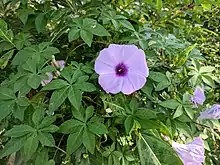Ipomoea cairica
Ipomoea cairica is a vining, herbaceous, perennial plant with palmate leaves and large, showy white to lavender flowers. A species of morning glory, it has many common names, including mile-a-minute vine, Messina creeper, Cairo morning glory, coast morning glory and railroad creeper.[1][2]
| Ipomoea cairica | |
|---|---|
 | |
| Scientific classification | |
| Kingdom: | Plantae |
| Clade: | Tracheophytes |
| Clade: | Angiosperms |
| Clade: | Eudicots |
| Clade: | Asterids |
| Order: | Solanales |
| Family: | Convolvulaceae |
| Genus: | Ipomoea |
| Species: | I. cairica |
| Binomial name | |
| Ipomoea cairica | |
| Synonyms | |
|
Ipomoea palmata Forssk. | |
Description
A hairless, slim climber with bulbous roots and lignescented base, its leaves are stalked with 2 to 6 cm long petioles. The leaf blade is ovate to circular in outline, 3 to 10 cm long and 6 to 9 cm wide. It is divided into five to seven segments, these are lanceolate, ovate or elliptic, entire and pointed at the tip and base. Often pseudo side-leaves are formed.[3]
The lavender-coloured inflorescences are one to a little bloody cymes. The flower stalks are 12 to 20 mm long, the sepals are 6 to 8 mm long, ovate and sting-pointed. The crown is funnel-shaped, 4 to 6 cm long and violet colored. The stamens and the stylus do not protrude beyond the crown. The ovary is hairless. The fruits are spherical capsules approximately 1 cm in diameter containing one or two hairy seeds. Each fruit matures at about 1 cm across and contains hairy seeds. [4]
Range
Its native range is uncertain, though it is believed to originate from a rather wide area, ranging from Cape Verde to the Arabian Peninsula, including northern Africa, the Mediterranean and the tropics. It covers walls, fences or trees, with stems that can measure more than 10 m in length. The altitude at which it has been recorded ranges from 250 to 2250 m. It blooms throughout the year, especially when it is well cared for.[5][6]
Invasive species
Because of human dispersal, it occurs today on most continents as an introduced species and is sometimes a noxious weed and an invasive species, such as along the coast of New South Wales. As well as in the United States, where it occurs in Hawaii, California, all the gulf coast states, as well as Arkansas and Missouri.[7]
Cultivation
Some plant nurseries sell this plant as an ornamental plant thanks to its showy purple flowers and as well for its fast growth to quickly cover unsightly fences or walls. It can grow as a separate plant if snapped during attempted removal process.[8] The plant causes respiratory symptoms if ingested.
Gallery
 Flower closeup in Hong Kong
Flower closeup in Hong Kong-1.jpg.webp)
 Wall cover in Hyderabad
Wall cover in Hyderabad As a groundcover
As a groundcover As a shrub
As a shrub Near a pond
Near a pond Growing on a bridge rail
Growing on a bridge rail Botanical illustration
Botanical illustration
References
- Ipomoea cairica (L.) Sweet, USDA PLANTS
- Colmeiro, Miguel: "Dictionary of the diverse vulgar names of many usual or notable plants of the old and new world", Madrid, 1871.
- Carranza, E. (2008). «Diversity of the Genus Ipomoea L. (CONVOLVULACEAE) in the State of Michoacán, Mexico». Flora of the Bajío and Adjacent Regions . Complementary Fascicle XXIII.
- S. Dressler, M. Schmidt, G. Zizka (ed.): African plants - A Photo Guide. Senckenberg, Frankfurt / Main 2014.
- Carranza, E. (2007). «Family Convolvulaceae». Flora of the Bajío and Adjacent Regions . Fascicle 151
- Invasive species group, Plants invasive for the natural environments of New Caledonia , Nouméa, Agency for the prevention and compensation of agricultural or natural calamities (APICAN),January 2012, 222 p. , pp. 110-111
- Ipomoea cairica (L.) Sweet, USDA PLANTS
- , Georgia Vines Cart